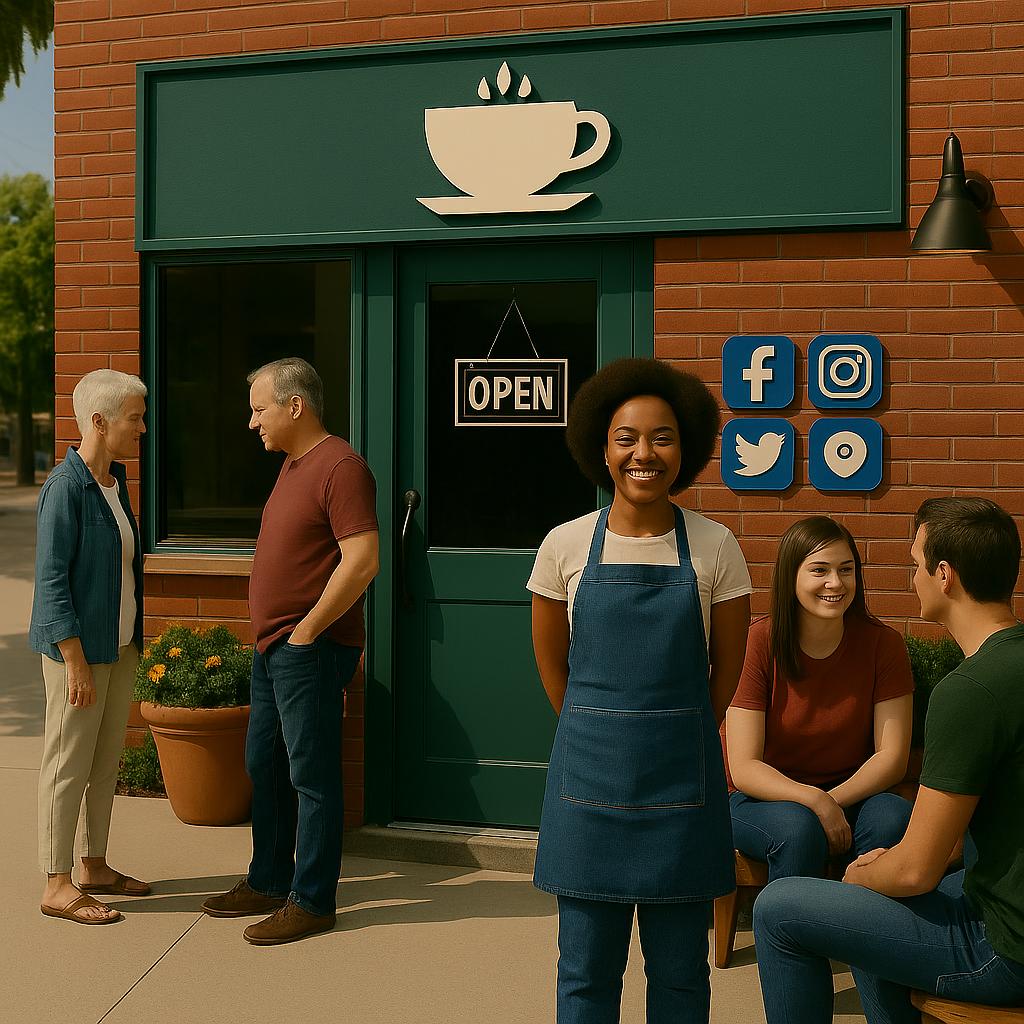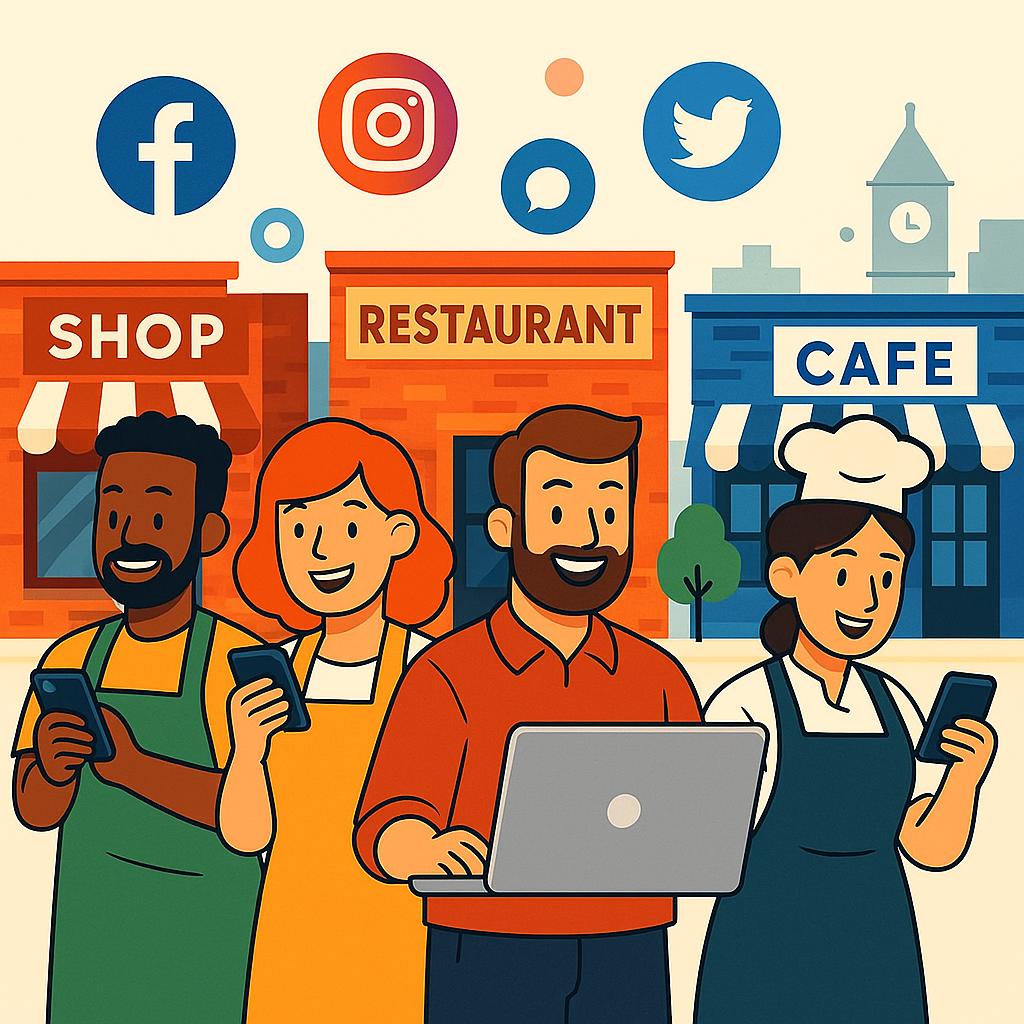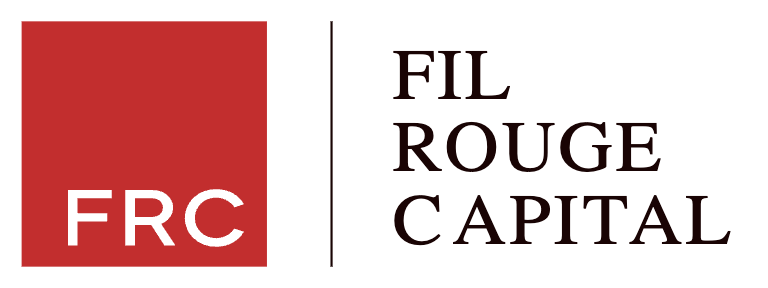People scroll with neighborhood intent. They look for a quick lunch, a same‑day service, or a place to bring family this weekend.
A brand that shows up with useful posts, clear directions, and friendly replies earns attention and action.
In short, local social media marketing helps nearby customers find a business, trust it, and show up.
It mixes content, community, and local signals like maps, tags, and events. Done well, it turns followers into foot traffic and phone calls.
In the sections below, we’ll explore platforms, practical strategies, and content tips to help your business reach local customers.
Local Social Media Marketing: What Is It and Why It’s Important
Local social media marketing focuses on reaching people in a specific city, neighborhood, or radius.
It uses features like location tags, local hashtags, and proximity targeting to reach likely buyers close to the store.
It’s important because social feeds act like a real‑time bulletin board for the area. People look for open hours, hair styling services, and what is new this week. Businesses that answer these needs show up first in minds and maps.
The Difference Between General and Local Social Media Marketing
General social media aims for broad awareness and national reach. Local prioritizes nearby reach, store visits, and calls within a tight radius.
- General: brand storytelling, national promos, macro trends.
- Local: neighborhood culture, hyper‑specific offers, directions and timing.
Content also shifts. National content may lean on polished campaigns. Local content shows real staff, local places, and timely updates that matter now.

Why It’s Essential for Small Businesses Today
Small teams need marketing that converts quickly. Local tactics turn posts into same‑day actions.
- People search and scroll near the point of purchase.
- Social profiles often outrank websites for “near me” intent.
- Google Business Profile signals, plus strong social proof, aid discovery and trust.
Best Platforms for Local Social Media Marketing
Each platform offers different local features. The right mix depends on audience, product type, and how often one can post.
Facebook for Local Communities and Events
Facebook remains a hub for city groups, school networks, and community events. Local Awareness and reach ads can focus on a small zone around the address.
Events, fundraisers, and neighborhood groups reward steady participation.
- Post short updates with hours, specials, and event reminders.
- Use a 5 to 10‑mile radius for promotions in suburban areas and 1 to 3 miles in dense cities.
- Check the Meta Business Help Center for guidance on location targeting and local ads.
Instagram and the Power of Location Tags
Instagram’s location stickers, Stories, and Reels help nearby users discover places. Strong visuals, clear captions, and map pins drive action.
- Tag the business location and nearby landmarks.
- Mix Reels that show a process, a before‑and‑after, or a quick walk‑through.
- Learn specifics in the Instagram Help Center on location tags.
TikTok and Short‑Form Local Storytelling
TikTok favors quick stories and real moments. Local businesses can show daily life, staff personalities, and the small details that make the visit worth it.
- Use short captions with the city name and niche hashtags.
- Film in recognizable neighborhood spots to spark comments and shares.
- Keep a steady cadence rather than chasing every trend.
LinkedIn for professional connections in your area
LinkedIn helps B2B firms, recruiters, and service providers meet local decision makers. Location targeting and industry filters narrow the audience to nearby buyers.
- Share case snapshots with local clients and outcomes.
- Join regional groups and weigh in on timely topics.
- Explore options in LinkedIn Business Solutions.
Nextdoor and Other Hyperlocal Networks
Nextdoor reaches neighbors who care about schools, safety, and local services. The tone is practical and community‑first. Short posts with clear offers and service details perform well.
- Verify the business profile and post in relevant neighborhoods.
- Address common questions about pricing, timing, and guarantees.
- See resources at Nextdoor for Business.
Quick platform comparison:
| Platform | Best local use case | Ideal content |
|---|---|---|
| Events, offers, community groups | Short updates, event promos | |
| Visual discovery and maps | Reels, Stories, carousels | |
| TikTok | Authentic short video | Behind‑the‑scenes, tips |
| B2B in metro areas | Case posts, hiring, insights | |
| Nextdoor | Hyperlocal services | Offers, FAQs, service pics |
Strategies for Effective Local Marketing
Winning locally is about accuracy, timeliness, and real conversations. Small moves repeated each week compound.
Use Local Keywords and Accurate Business Details
Profiles should match across platforms. That includes name, address, phone, hours, and categories.
In captions and bios, add city names and neighborhood terms people actually use.
- Implement keywords like: “Chicago dog groomer,” “Capitol Hill coffee,” “Plano pediatric dentist.”
- Add parking info, transit tips, and entry details. These remove friction for new visitors.
- Place directions, menu links, and booking buttons high in the profile.
Collaborate With Nearby Influencers or Partners
Local creators and micro‑influencers bring trust. A fitness coach, a PTA leader, or a neighborhood foodie can introduce a brand to a ready audience.
- Offer a clear value exchange: products, services, or a donation to a local cause.
- Co‑host an event or limited special. Share assets and split the promotion schedule.
- Track referral codes or a unique booking link to measure impact.
Highlight Local Customers, Causes, or Events
Social proof from real neighbors builds confidence. Featuring community work and local wins signals that the business is part of the area, not just in it.
- Share quick testimonials with a first name and neighborhood.
- Support school drives, cleanup days, and charity runs.
- Post recaps with photos and a thank‑you to volunteers.
Encourage Real Conversations With Your Community
Two‑way replies change perception fast. Short, helpful answers beat long scripts.
- Respond to comments within a business day. Use names when possible.
- Ask simple questions: “What hours work best on Saturdays?” or “Which flavor should return next month?”
- Document wins with metrics that matter.
How to Create Engaging Local Content
Great local content shows the place, the people, and the timing. It should feel like it comes from around the corner, not a studio far away.
1. Tell Stories Rooted in Your Neighborhood
Stories travel when they carry local detail. Mention a street, a landmark, or a seasonal ritual people recognize.
- A bakery might share how it prepares paczki before Fat Tuesday, with a quick shot of the morning line.
- A bike shop could film a 15‑second safety tip at a known intersection.
If you have longer material, you can repurpose it into short clips and carousels.
2. Feature Recognizable Places and Faces
Faces, storefronts, and nearby views perform well. They make the content feel close and credible.
- Film staff handing over a finished product at the pickup counter.
- Show a quick pan of the block so people know exactly where to go.
- Explore post formats that spark comments and saves.
Reflect Local Culture, Humor, and Values
A joke about the weather or a nod to a local team can warm up the feed. Keep humor kind and inclusive.
- Use captions that sound like a helpful neighbor.
- Avoid slang that may confuse visitors or older audiences.
- When scaling output, consider careful use of AI for captions and hooks.
Stay Timely With Seasons and Community Happenings
Calendar rhythm drives relevance. Tie offers to school breaks, sports schedules, and city festivals.
- Share updates the week before key weekends and early each event day.
- Align staffing and inventory with expected demand.
- Plan when to post on each platform.
Simple weekly content cadence:
- Monday: quick update on specials, hours, or openings.
- Wednesday: story or Reel with a recognizable spot or process.
- Friday: weekend preview with a clear call to action.
- Sunday: recap and thank‑you to customers or partners.
Creating quality local content takes time and focus. Stryng is an AI powered content marketing platform that helps you write, edit, and publish posts for blogs and social media in one place. You can try Stryng for free to see how it supports consistent, SEO optimized publishing, or reach out to the Stryng team for full content and campaign management.
Why Many Local Campaigns Fail
Avoidable errors sink good creative. Most problems trace back to data hygiene, tone, or follow‑through.
Ignoring Location Data or Inconsistent Branding
If the address, hours, or categories are wrong, every other tactic underperforms.
Inconsistent logos or color schemes also confuse people.
- Fix NAP details across profiles.
- Keep a shared brand folder with current logos and colors.
- Use one short bio template with city keywords and a primary action.
Sounding Too Generic or Overly Promotional
People tune out ads that could belong to any city.
They also ignore constant discounts with no story or proof.
- Add specific neighborhood references and customer outcomes.
- Balance offers with service tips, behind‑the‑scenes, and sincere thank‑yous.
- Limit sales posts to a reasonable ratio, such as one promo for every three helpful updates.
Neglecting Interaction With Followers and Feedback
Comments and DMs signal interest. Silence kills momentum.
- Reply quickly with friendly, useful answers.
- Turn repeated questions into saved replies or a pinned post.
- Share improvements made because of feedback.
Summary
Local social media marketing wins when a business looks and sounds like a helpful neighbor.
- It works best when profiles, hours, and location data are accurate and consistent.
- Short, clear posts with geo tags and community context outperform generic brand messages.
- A simple plan with weekly rituals, light community management, and geo‑targeted ads can drive measurable results.
- Partnerships with nearby creators, charities, and events strenghten trust faster than polished brand content alone.
It all adds up to one goal: becoming the local brand people remember first.
Frequently Asked Questions
Q: How often should a small business post to reach nearby customers?
A: Two to four times per week is plenty for most teams. Focus on quality and timing. Share quick stories from the floor and add location tags.
Q: Which metric matters most for local success?
A: Track actions that tie to revenue. Calls, directions taps, bookings, and redemptions beat likes every time.
Q: Are geo‑targeted ads necessary for local results?
A: Organic reach can work, but paid support speeds outcomes. Small radius campaigns help new people notice the business and take the next step.
Q: How does Google Business Profile relate to social content?
A: Keep profiles aligned. Photos, categories, hours, and reviews should match. Consistency helps people trust the brand and reduces confusion.
Q: What is community management in this context?
A: It means replying to comments and messages, resolving issues in public when possible, and thanking people for visits or referrals. This steady work builds loyalty fast.



